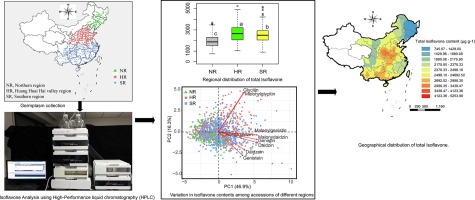Food Research International ( IF 7.0 ) Pub Date : 2019-12-28 , DOI: 10.1016/j.foodres.2019.108957 Muhammad Azam 1 , Shengrui Zhang 1 , Ahmed M Abdelghany 2 , Abdulwahab S Shaibu 1 , Yue Feng 1 , Yanfei Li 1 , Yu Tian 1 , Huilong Hong 1 , Bin Li 1 , Junming Sun 1

|
Soybean (Glycine max L. Merrill) isoflavones are secondary metabolites of great interest because of their beneficial impact on human health. We profiled the seed isoflavone composition of 1168 soybean accessions collected from diverse ecoregions of China in three locations over two years. We observed significant differences in isoflavone content among the accessions, accession types, years of growth and ecoregions of origin. Total isoflavone (TIF) concentration of the soybean accessions ranged from 745 μg g−1 to 5,253.98 μg g−1, which represents a 7-fold difference. The highest mean TIF concentration (2,689.27 μg g−1) was observed in the Huang Huai Hai Valley Region (HR) accessions, followed by accessions from the Southern Region (SR) and Northern Region (NR) with TIF concentration of 2,518.91 μg g−1 and 1,942.78 μg g−1, respectively. Thirty-five accessions were identified as elite soybean resources based on their higher TIF concentration (4,024.74 μg g−1 to 5,253.98 μg g−1). Pairwise correlation analysis showed significant positive correlations between individual isoflavones and TIF concentrations. Malonyldaidzin and malonylgenistin showed the highest correlations with TIF concentration (r = 0.90 and r = 0.92, respectively), whereas acetyldaidzin showed the lowest correlation. The main isoflavone components had significant negative correlations with latitude and longitude, indicating that the geographical origin of the accessions influenced their seed isoflavone composition. Based on principal component analysis, glycosides and malonylglycosides of isoflavones were the major discriminative components for the soybean accessions. The present study demonstrated the geographical distribution of soybean seed isoflavone concentrations across the main ecoregion of China. The identified soybean accessions with both high and low TIF concentrations, which are desirable materials for industrial uses and could also be used as parents to breed soybean lines with improved isoflavone quantity and composition in the seeds.











































 京公网安备 11010802027423号
京公网安备 11010802027423号